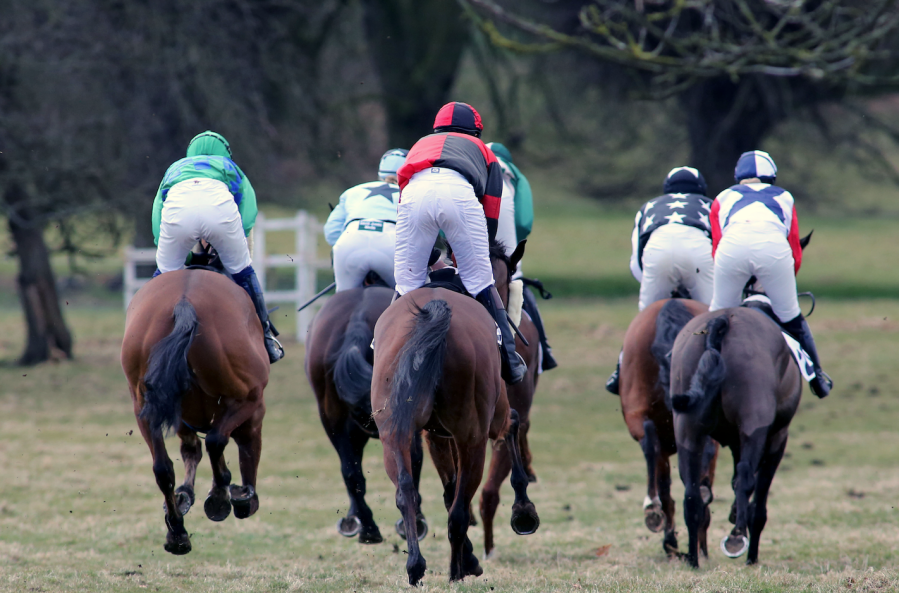When a horse falls at the fence that equine vet Kieran O’Brien is standing at while on duty at a point-to-point, his worst fears are confirmed when the Thoroughbred is unable to get back up, leading to a heart-breaking decision in the middle of the course.
“Time to go,” I tell the group of three vets I am standing with. We are outside the hospitality tent at a Devon point-to-point race meeting. The other vets on duty with me are each from local equine veterinary practices, and all are very experienced. Although all four of us have been in this role at many point-to-points in the past, there is a shared feeling of slight apprehension between us. We will be working in the public eye. Serious injuries can occur on the racecourse requiring quick — and possibly life-ending — decisions. These may have to be made in full view of the crowd.
From our hilltop viewpoint below us, the course stretches away into the distance across the Devon countryside, and we can see just four of the eight fences. The other four fences are hidden behind the high hedgerows that divide the fields. It is mid-February, and a chill wind blows across the venue. We are dressed in warm clothes and rubber boots, and we each sport a badge declaring we are veterinary surgeons. Our four-wheeled drive vehicles, parked nearby, are fully equipped to deal with any on-course emergency, principally accidents due to horses falling at fences.
‘Pointing’ is amateur jump racing usually over a temporary course, and often built on the same group of adjacent farms every year. The local hunt organises one annually as a fund raiser. Pointing’s link with hunting is a strong one, and for most hunts its annual point-to-point — along with the Hunt Ball — is an important winter social occasion, where the horsey community, farmers and landowners meet. Attending their local point-to-point is also an important annual ritual for many country people. Picnics are brought and liberal quantities of port are dispensed from the boots of cars.
On this occasion the huntsman, at the edge of the paddock, resplendent in his scarlet coat and highly polished boots, sits on his impeccably turned out and plaited chestnut horse. Removing his polished copper hunting horn from its holder at the front of the saddle, he blows a short note when the bowler-hatted chief steward nods to him to indicate it is time for the horses, now parading round the paddock, to go to the start. They are led onto the course by their grooms and released to follow the huntsman as he canters down the hill to the start.
I have a double dose of a strong sedative to hand
As the chief vet, my job is to ensure that my team of vets are correctly deployed on the course to ensure every faller can be reached quickly if first aid is required. Normally vets are assigned to two or three fences each. Once everyone is in position, I do a quick radio check to ensure our communications are working.
I am responsible for the fourth and fifth fences at the far end of the course. These will each be jumped three times during the race. From where I have parked, I can see the landing side of the fourth fence and the take-off side of the fifth. I check my equipment. I have a pre-filled syringe immediately to hand containing a double dose of a strong sedative in case I need to quickly sedate an injured horse to keep it still while it is treated. Large doses are needed as the adrenaline-charged racehorse, despite its injuries, will want to follow their comrades that are now galloping away towards the next fence. I am wearing gloves to ensure my hands are warm and I retain the necessary dexterity on this bitterly cold day.
I faintly hear the huntsman, waiting at the start, blow on his horn the characteristic staccato notes of ‘Gone Away’, the traditional way of indicating a race has started. The sound of hooves starts to amplify as the horses approach my position. Almost as one they come into view as they jump the fourth fence and gallop to the fifth. Once they land, I quickly count them as they race on to the fifth. I count eight horses, so no fallers so far.
Close to me at the fifth fence the leading three horses jump together closely followed by the fourth. This horse, misjudging the correct take-off point, hits the fence hard and falls to the ground with his head outstretched, catapulting the jockey to the side. The remaining four horses fortunately jump to one side of the fallen horse and carry on.
The recumbent horse shows no inclination to rise
The horse lies on his side, breathing heavily. His jockey, mercifully uninjured, quickly regains his feet and stands close by, watching the horse. I start my car and drive quickly to the fence, but not close enough to risk disturbing the recumbent horse. It is not unusual for horses to lie on the ground for a brief period after falling, in a state in the racing world known as ‘winded’. Most will stand up without assistance and uninjured after a few minutes.
We stand watching the horse, not overly concerned as we expect him to rise very soon. As a precaution to prevent him running off when he does, the jockey lifts the reins over his head and stands with them in his hand. By now the horses are approaching on their second circuit so I instruct the fence stewards to place a large marker on the fence indicating that it must be bypassed, as they will not see the stricken horse still lying on the landing side.
The horses thunder past a gap at the side of the fence. I count seven — no more fallers so far. The recumbent horse raises his head slightly but shows no inclination to rise. With my stethoscope I listen to his heart — all normal. I inspect his nostrils — no visible blood. Although he has been recumbent now for about five minutes, I resolve to give him more time. The horses now gallop past for the third and final time. The prone horse shows more interest in their passing this time, but still makes no attempt to rise.
My worst suspicions are confirmed
The race is over, and it is time to act. The horse ambulance arrives, and we erect a screen around the horse. We place a strong headcollar on him and remove the saddle. I check for a spinal or head fracture, and for internal haemorrhage. The horse is on his side and the two upper limbs appear normal. Lifting the lower forelimb slightly I notice the horse responds and makes a half-hearted attempt to withdraw it from my hand. I now have a strong suspicion what the issue is.
Applying ropes to the three limbs and with the help of the trainer — who has now arrived — we flip the horse over onto his other side. He quickly stands up with a little difficulty and is a bit wobbly. I look at the forelimb that was underneath and my worst suspicions are confirmed — a fracture of the humerus, the large bone that connects the shoulder to the elbow.
The limb is held at an unusual angle. Holding the horse’s knee, I gently move it sideways and feel through my hand the two ends of the fractured bones grating against each other — a dreadful sensation that once felt is never forgotten.
I administer a sedative to the horse while we assess the situation. The face of the trainer, without any discussion, indicates that he knows what must be done. This is a fracture that cannot be repaired. With my radio I summon a colleague to obtain a confirmatory second opinion, as is standard practice on racecourses in the event of a potentially fatal injury.
The horse must be destroyed
We examine the horse together and agree. The horse must be destroyed. A tearful owner then arrives, looks at the abnormal position of the limb and starts to walk away without commenting. Her daughter remains, and through her sobs asks if anything can be done to save the horse she has loved since it was a few minutes old. I say no.
The horse is likely in a lot of pain, and we must not delay. Very gently we persuade the owner’s daughter to release her tearful embrace from the horse’s neck and stand to the side. I draw up the euthanasia solution into a syringe, place an intravenous catheter in the horse’s neck and slowly inject.
He starts to breathe deeply, signalling imminent collapse. He falls on to the side of the fractured leg, which is now protruding at a disturbing angle from his body. I check his heart and confirm it has stopped. It’s over. Nobody speaks. The lovely Thoroughbred now lies motionless, a victim of a sport that can kill.
Missed part one? Kieran was on duty at a local hunter trial, where he treats a horse’s injured hind leg, advises on a superficial tendon injury and jumps into action when he witnesses a terrifying rotational fall.









